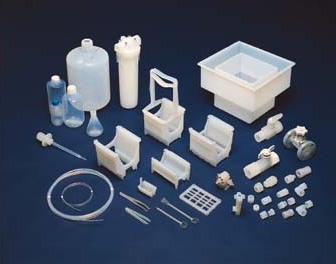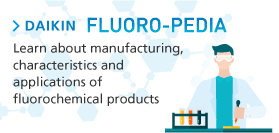NEOFLON PFA AP-Series

NEOFLON PFA AP-Series has excellent heat resistance, chemical resistance and weatherability. It resembles PTFE but can be melt-molded. The high-purity PFA-SH series has made big achievements in the manufacturing process of semiconductors due to the low elution of fluoride ions and particles.
Daikin lines up product items of general grade, high purity grade, and antistatic grade.
DESCRIPTION
Feature
- A copolymer of tetrafluoroethylene and perfluoroalkylvinyl ether.
- Various melt molding methods are available such as extrusion molding, injection molding, transfer molding, and compression molding.
- It has been used in many semiconductor sites due to its highly purity by stabilizing treatment of end groups.
- Heat resistance, inertness for almost all chemicals and excellent weatherability.
- Retains mechanical strength at a wide temperature range from-200°C to 260°C.
- It is excellent in electrical insulation and high-frequency characteristics. It effectively works in the field of electronics such as high speed communication cables.
- It has excellent flame retardancy (limiting O2 index 95 vol%, UL94V-0).
Applications
NEOFLON PFA AP-Serie has excellent heat resistance, chemical resistance and electric properties as well as PTFE. It is designed to be compatible with various melt forming methods.
- Composite injection molded part
- Life science
- Wire and cable
- High-purity tubes and bottles
- Filming
- Sheet for corrosion resistant lining
Technical report
We assume that in order to discuss the possibility of residence of nano-sized particles on the inner surface of PFA tubes for semiconductor manufacturing equipment, the method for measuring the surface roughness inside the tubes must be newly invented. This report makes a proposal for a method to measure surface roughness at the nano-level and demonstrate the necessity for this measurement.
GRADES & FEATURES
| GRADES | DOWNLOADS |
|---|---|
| AP-201 | TECHNICAL DATA SHEET |
| AP-202 | TECHNICAL DATA SHEET |
| AP-210 | TECHNICAL DATA SHEET |
| AP-230 | TECHNICAL DATA SHEET |
|
AP-201SH |
TECHNICAL DATA SHEET |
| AP-211SH | TECHNICAL DATA SHEET |
| AP-221SH | TECHNICAL DATA SHEET |
| AP-230SH | TECHNICAL DATA SHEET |
| AP-231SH | TECHNICAL DATA SHEET |
| AP-230AS | TECHNICAL DATA SHEET |
| AP-230ASL | TECHNICAL DATA SHEET |


